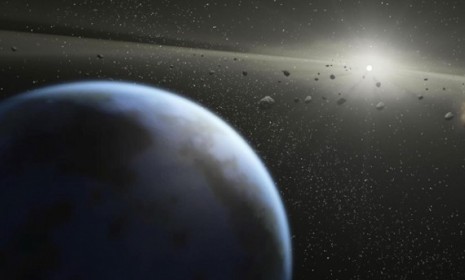The 5 most potentially inhabitable alien planets
Scientists rank the exoplanets most likely to have the rare ability to harbor life — though the chances are still pretty slim

The more we learn about the universe, the less likely it seems that Earth is the only planet with an atmosphere that's conducive to supporting life. And the space pros from Arecibo's Planetary Habitability Laboratory (PHL) at the University of Puerto Rico have in fact identified five other places in the universe that could be the next Earth, detailing in a new list what they consider to be the five most potentially inhabitable exoplanets, or worlds outside of our own solar system. Here they are, in order:
1. Gliese 581g
Topping the list is a rocky world that may not even exist. The exoplanet Gliese 581g, which is 20 light-years away and perhaps two to three times as massive as Earth, was discovered in September 2010, but its existence is a point of contention among critics, because of what was then believed to be a non-circular orbit. Still, newer findings suggest that Gliese 581g is indeed real, and is "probably nice and Earthy warm," says Rebecca Boyle at Popular Science, inhabiting a "Goldilocks zone" that gives it roughly the same surface temperature as our planet, thanks to a desirable proximity to its own red dwarf star.
The Week
Escape your echo chamber. Get the facts behind the news, plus analysis from multiple perspectives.

Sign up for The Week's Free Newsletters
From our morning news briefing to a weekly Good News Newsletter, get the best of The Week delivered directly to your inbox.
From our morning news briefing to a weekly Good News Newsletter, get the best of The Week delivered directly to your inbox.
2. Gliese 667Cc
Discovered in February 2012, this massive exoplanet is at least 22 light-years away and orbits a red dwarf in the constellation Scorpius. The "super Earth" is 4.5 times larger than our planet, and completes an orbit every 28 days. Unlike our planet with its single sun, however, Gliese 667Cc resides in a triple-star system, "so the planet's night sky would probably be a sight to behold," says Mike Wall at Space.com.
3. Kepler-22b
This exoplanet was spotted by NASA's planet-hunting Kepler space telescope, which has detected more than 2,300 potentially inhabitable worlds since it was first used in March 2009. Kepler-22b was the first confirmed to officially exist in the "habitable zone," or the set of conditions that a potential Earth-clone would need to meet to be deemed livable. It boasts a "balmy temperature" of 72 degrees, which would theoretically support the existence of liquid water.
A free daily email with the biggest news stories of the day – and the best features from TheWeek.com
4. HD 85512b
This alien world 35 light-years away has an estimated surface temperature of 77 degrees. HD 85512b is about 3.6 times "as massive as our planet," says Space.com's Wall, but beyond that little else is known. Follow-up work is needed to understand exactly how the exoplanet orbits its star, says Discovery News. "Is it a rocky, truly Earth-like world? Does it have an atmosphere? If it does, is the atmosphere thick like Earth's; as suffocating as Venus'; or, as tenuous as Mars'?" The answers are all unknown.
5. Gliese 581
The largest exoplanet on the list is roughly seven times as massive as Earth, and orbits the same sun as its Gliese siblings, says Space.com's Wall. Discovered in 2007, Gliese 581 is probably too cold to be habitable, although recent studies suggest it could in fact be warmed by greenhouse gases, which gives it some potential to harbor life.
Sources: Discovery, Popular Science, Space.com
-
 Zimbabwe’s driving crisis
Zimbabwe’s driving crisisUnder the Radar Southern African nation is experiencing a ‘public health disaster’ with one of the highest road fatality rates in the world
-
 The Mint’s 250th anniversary coins face a whitewashing controversy
The Mint’s 250th anniversary coins face a whitewashing controversyThe Explainer The designs omitted several notable moments for civil rights and women’s rights
-
 ‘If regulators nix the rail merger, supply chain inefficiency will persist’
‘If regulators nix the rail merger, supply chain inefficiency will persist’Instant Opinion Opinion, comment and editorials of the day